The little boat that could
Published on June 5th, 2022
All it took was a year of elbow grease and a little bit of TLC for Alex Simanis to get his newly restored Pt Bonita 27, Pell Mell, back into the water and titled a winner. The smallest boat on the course for the duration of the 2022 California Offshore Race Week (CORW) has proved that it is heart and skill that gets you first overall, not size.
The week-long journey down the California coast is broken into three separate races and is hosted by Encinal Yacht Club, Monterey Peninsula Yacht Club, Santa Barbara Yacht Club and San Diego Yacht Club. Skippers and crews are encouraged to participate in the entirety of the CORW, but have the option to opt into any of the individual legs.
Spinnaker Cup (San Francisco to Monterey, 86 miles): May 28-29
Coastal Cup (Monterey to Santa Barbara, 204 miles): May 30-May 31
SoCal 300 (Santa Barbara to San Diego, 245 miles): June 2-4
San Diego Yacht Club’s hosted leg of the race with Santa Barbara Yacht Club, the SoCal 300, started as a stand alone event. In 2016, the race synced up with the Spinnaker Cup and the Coastal Cup, resulting in the California Offshore Race Week.
Simanis’ Pell Mell is the official winner of not just the SoCal 300, but the overall series winner of CORW. Originally built in the mid 80’s, the Point Bonita 27′ Pell Mell was designed to be more of a cruiser, with inspiration from the Dogpatch 26, without the hard chines below the waterline. Her ample room below decks makes things more comfortable for distance-racing.
Simanis found the boat languishing in Poulsbo in the Pacific Northwest West, and spent an entire year bringing her into her potential, and this past October, she returned to the water and began collecting trophies. Crewing with Simais were Ben Towery, Elishia Van Luven, and Joseph Wilderman.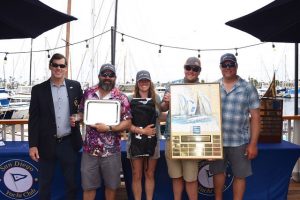
Simanis commented, “The Spinnaker Cup was epic. We stuck with our plan of staying out and waiting for the new breeze to come, and it worked out well. The last 50 miles we did in about 6 hours and we came into Monterey on a nice angle and 25+ knots of breeze. For the SoCal 300, it was a beautiful jib reach to the islands. We thought it was going to be game on, but it was really light.
“We got stuck in the island and had to battle back and forth to find a lane. A bunch of the fleet moved more to the west and we ended up sneaking towards more of the east breeze that filled in. We were able to catch up to the 1D35 and J/111 and the bigger boats for the run. Our boat is pretty quick on the run, so nobody got away from us.”
This was the first time Simanis and his crew took Pell Mell out to the ocean. The team will be competing in the Ditch Run next weekend on their way home to Seattle before settling back into beer can races and cruising. Simanis plans to return to CORW next year.
The Series scoring came down to a tie in the end. Finishing the series alongside Pell Mell with eight points was Rodney Pimental’s Cal 40 Azure, who took second overall. Azure has sailed the Offshore Race Week five out of six years in the Series’ history.
The journey for the fleet started a week ago on Saturday, May 28, with the Spinnaker Cup. Thirty boats crossed the starting line in San Francisco and set sail on the first leg of the race down to Monterey. There were some early and aggressive forecasts that predicted high winds which influenced some competitors. Those who took the risk and started the race quickly realized that weather forecasting is not an exact science.
After a “normal” start, the Spinnaker Cup turned uncharacteristically light, with competitors at the halfway point fighting light winds at sundown. But not long after, the wind filled in and everyone powered to the finish. That slowdown resulted in an overall longer race with first to finish Fast Exit II crossing the finish line a little after 0100, 3 hours later than the typical “before midnight” finish of prior years.
“Monterey Peninsula Yacht Club did an awesome job meeting the competitors on the water at all hours of the night and ushered us with flashlights to our slip,” Andrew Picel on J/125 Arsenal commented. It was a great way to finish the first race of the CORW series for Picel who is new to offshore racing.
Pell Mell started off strong, finishing first overall for Spinnaker Cup in front of second place Jeff Mulvihill’s Olson 30 Werewolf and Marc-Andrea Klimaschewski’s Dogpatch 26 Moonshine in third.
Chris Busch, aboard R/P 52 Vitesse, commented on the Spinnaker Cup, “Class A enjoyed a nice medium air beat out SF Bay with some close racing and one close encounter by a whale just outside the south tower of the Golden Gate Bridge on Artemis.
“Once rounding Mile Rock, it was a long starboard fetch with a jib eased to the rail, but instead of the wind building and going right like a typical Spinnaker Cup, the wind died and headed us to where we were left paying shifts upwind in patchy conditions and beating our way down the coast. At one point, someone onboard Vitesse renamed the race the Drifter Cup. Once the wind built, it was an exciting finish on Vitesse who battled it out with Fast Exit II for first to finish.
“Fast Exit II came in from the west on a hot angle and we converged about 20 miles from the finish. We gybed ahead and to windward and were able to hold them off as we passed close by the Point Pinos headland and the final 4-mile VMG run to the finish.”
Ted Floyd is a past Coastal Cup event chair and regular crew member on the Cal 40 Azure who have a tight group that have sailed together for many years. With tricky conditions in the Spinnaker Cup, Floyd was relieved to have experienced drivers.
“We had a great sail out the gate and down the coast to Monterey for the Spinnaker Cup. It was nice to be competing directly with the other Cal 40s in our division. We posted a 2nd place finish after Red Head passed us just coming into Monterey. Congratulations to Walt, Peter, and the crew for edging us out.”
The Coastal Cup was a whole different story. Floyd reported, “We had a great start out of Monterey and turned south under reefed main. After making the turn, we shook the reef and set a shy kite for the run to Santa Barbara. The breeze built into mid-to-high 30s and gusts up to 40 knots. Wahoo! We chose the right place to jibe at Point Conception and had a good run to finish first across the line in our division. Our only damage was a broken traveler, which we repaired underway.”
Unfortunately for Vitesse, praise for the wind gods came to a halt mid-race. After chewing up the miles to Santa Barbara in 30+ knots of breeze, the team heard a loud bang from a broken bobstay, which connects the outboard end of the bowsprit to the hull, and takes all the load from the spinnaker. This marked the end of their spinnakers for the race.
Vitesse crew Busch commented, “Fortunately, with the wind still in the high 20s, a small jib, GS, and a reef in the main is still a quick combination albeit only about 80% of what we should be doing. We converged with Artemis and Pied Piper as we entered the Santa Barbara Channel and had a tight race to the finish but were overtaken without the ability to fly a spinnaker downwind as the breeze dropped.”
Vitesse still finished the race in third place, and ended up first in their CORW Class A for the series. The silver lining for Vitesse is that the CORW was a tune-up for Transpac 2023, and now the team can mend the weak spots and prepare the boat for next summer.
Coastal Cup finished with Jack Jennings’ Santa Cruz 70 Pied Piper in first, and Andrew Picel’s J/125 Arsenal in second.
Picel reflected, “We are all pretty energized at the start of the Coastal Cup because we knew what we were in for.” Being new to ocean racing and the exposure to blue water conditions (30+ kts of wind and 3-4 meter waves) “we had a realistic perspective of what we were capable of. Even under white sails alone (no spinnakers, just working sails) we were sailing at 20+ kts.”
John Raymont, skipper of the Ker 51 Fast Exit II shared a similar approach. He has a well-seasoned crew, but still takes time before all races to run through a vessel safety brief based on one included in a prior CORW Notice of Race. This exercise proved prophetic for the Coastal Cup in preventing a dangerous situation from occurring.
During the safety brief, the team discussed using 3-foot, rather than 6-foot, tethers to keep crewmembers attached to and near the boat and to mitigate risks of going overboard while working on the foredeck. Just hours later, during the race, at one point, Fast Exit II dug its bow deep into a wave and one of the crew working forward of the mast was washed overboard.
Since he was on the short 3-foot tether, it was just a quick effort to get him back aboard. By using the safety debrief process to vet challenges in blue water sailing, the Fast Exit crew had avoided the risks associated with longer tethers that would have put prospective overboard crew significantly lower than the deck, possibly in the water and subject to a whole other level of danger.
To quote a sentence from the Vessel Safety Brief that sums up the philosophy offshore: “Being safe is about adapting appropriately to the conditions with your given crew and skill set in a timely manner, before an emergency happens.” Thank you to all the competitors for exercising prudent seamanship and playing safe in Mother Nature’s playground.
The final leg of the Offshore Race Week was from Santa Barbara to San Diego – the SoCal 300. After a nice start, the fleet easily fetched out to Santa Cruz Island and bore off for Tanner Bank 100 nm south. The larger Class A and B boats then ran into the lee wind shadow of San Clemente made more sticky by prevailing light winds all along the coast.
The Class C, D and E boats quickly closed the 60 mile gap to less than 20 miles. Those were tough miles. Nine boats ended up retiring at this point. Some were due to equipment failures, one had a medical issue, and others assessed that “the conditions weren’t sustainable for their timeline.” John Brynjolfsson on his TP52 Saga reported moving only four miles in four hours around 60 miles from San Diego. Saga abandoned the race.
The other TP52, Mark Surber’s Bribon, persevered and took home a second place trophy in their class, just behind Fast Exit II.
First to finish the SoCal 300 was John Raymont on Ker 51 Fast Exit II. Raymont commented, “We had a great sail out to the virtual mark 100-nm offshore doing very well against our competition. After rounding and heading towards San Diego the breeze started to drop, allowing those behind us to catch us and the other boat-for-boat leaders, compressing the fleet. Most of the day has been in stop and go breeze hunting conditions.”
George Hershman on RP 63 GoodEnergy reported as they retired from the race, “No wind right now, all boats are drifting. Fifty miles from the finish.”
The 2022 SoCal 300 elapsed times varied between 31 hours and 39 hours, and were faster than the 2021 edition average of 50 to 60 hrs across all fleets. Out of the 23 boats that started the SoCal 300, 16 boats finished. Eleven sailed the entire Offshore Race Week. Awards for the SoCal 300 and the Offshore Race Week were held at the San Diego Yacht Club.
Look for the next edition of the California Offshore Race Week returning around Memorial Day 2023.
Event Details – Entry Lists – Results – Tracker
Source: San Diego Yacht Club


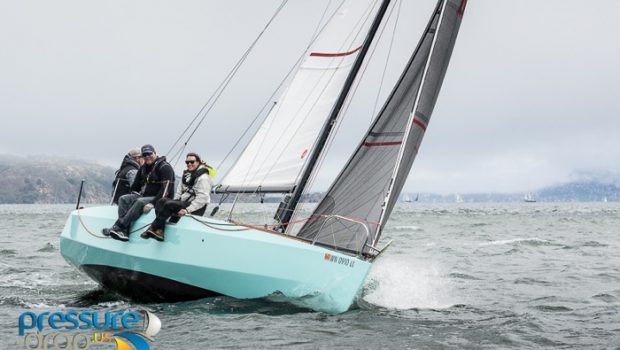


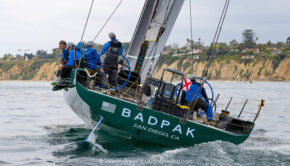
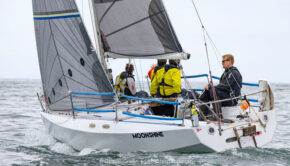
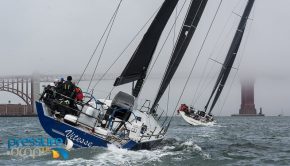
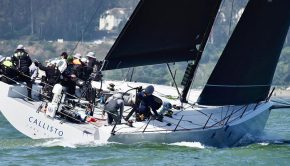
 We’ll keep your information safe.
We’ll keep your information safe.